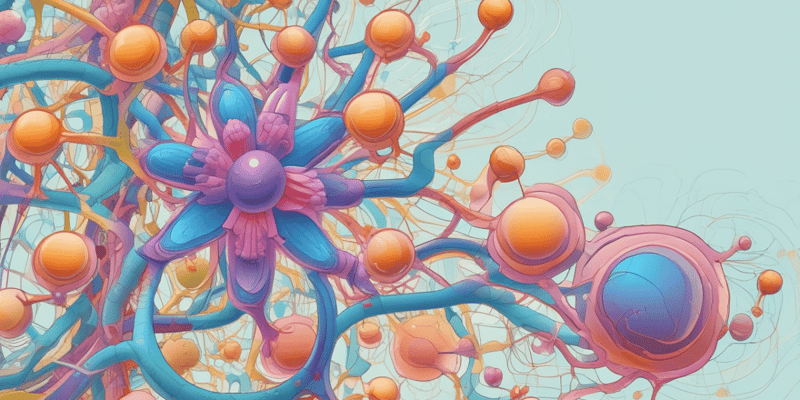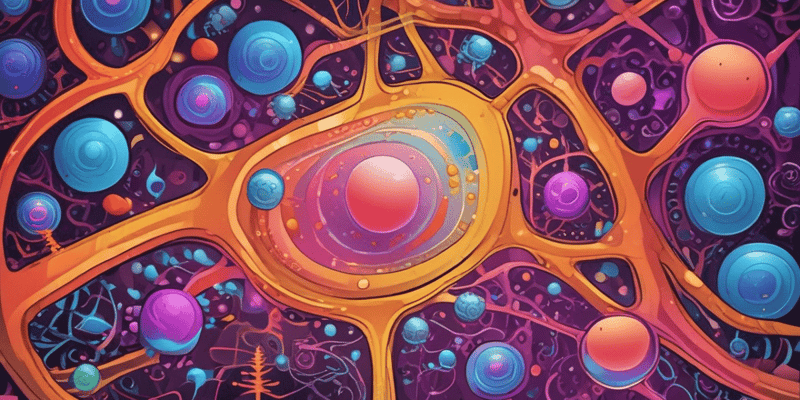30 Questions
Where is the phospholipid cardiolipin concentrated in the mitochondria?
Inner membrane
What is the role of Complex IV in the respiratory chain?
Reducing O2 to H2O
Which complex is also a component of the Krebs cycle?
Complex II
What is the function of the mitochondrial inner membrane?
Preventing H+ ions from leaking out
Where is Co-enzyme Q located?
Hydrophobic part of the inner mitochondrial membrane
Where does Cytochrome c bind?
Outer side of the inner mitochondrial membrane
What is the main function of the respiratory chain?
To oxidize reducing equivalents and act as a proton pump
Which of the following electron carriers accepts 2 electrons?
All of the nucleotide forms
Where is creatine kinase found in the mitochondria?
Intermembrane space
What is the byproduct of the citric acid cycle?
GTP
Which of the following is NOT a product of glycolysis?
GTP
What is the purpose of the Electron Transport Chain?
To synthesize ATP through oxidative phosphorylation
What is the cofactor involved in the oxidation of substrates such as succinate, glycerol-3-P, and acyl-CoA?
FADH2
What is the result of increasing the availability of ADP in mitochondria?
Increased rate of respiration
What is the function of the adenine nucleotide translocase or ATP/ADP antiporter?
Transport of ADP into the mitochondria and ATP out of the mitochondria
What is the process by which electrons are transferred to complex II or coenzyme Q, resulting in the formation of 1.5 mol of ATP?
Oxidative phosphorylation
What is the relationship between oxidation and phosphorylation in the respiratory chain?
Oxidation and phosphorylation are tightly coupled
What is the number of moles of ATP formed when 1 mole of the substrate is oxidized and electrons are transferred to complex II or coenzyme Q?
1.5 mol
Where does the electron pair carried with NADH+H always enter the respiratory chain from?
Complex I
Which of the following is produced from the total 3 NADH+H, 1 FADH2, and 1 GTP in the citric acid cycle?
13 Electron Flow
What is the total proton pump from the matrix into the intermembrane space if the electron pair enters the respiratory chain via FADH2?
6 H+
What is the role of malate-aspartate shuttle in the citric acid cycle?
To transfer electron pair from NADH+H
Which enzyme is involved in the transfer of electrons from FADH2 to Coenzyme Q in the citric acid cycle?
Succinate dehydrogenase
What is the purpose of transferring NADH+H to the respiratory chain?
To continue aerobic glycolysis
What is the function of a symporter of Pi and H+ in the mitochondria?
To transport Pi and H+ from the cytosol to the matrix
What is the effect of uncouplers on the respiratory chain?
They dissociate oxidation from phosphorylation, stopping ATP synthesis
Which inhibitor targets Complex I of the respiratory chain?
Rotenon
What is the function of Thermogenin in brown adipose tissue?
To generate heat by dissociating oxidation from phosphorylation
What is the effect of 2,4-dinitrophenol on the respiratory chain?
It dissociates oxidation from phosphorylation
What is the result of uncouplers on the rate of respiration?
It increases the rate of respiration, making it uncontrolled
Study Notes
ATP Synthesis
- ATP synthesis occurs through two mechanisms: substrate level phosphorylation and oxidative phosphorylation.
- Substrate level phosphorylation occurs in the cytoplasm during glycolysis.
- Oxidative phosphorylation occurs in the mitochondria and involves the electron transport chain (ETC) and ATP synthesis.
Electron Transport Chain (ETC)
- The ETC oxidizes reducing equivalents (-H or electrons) from carbohydrates, fatty acids, and amino acids and acts as a proton pump.
- The ETC consists of four electron carriers: NAD (nicotinamide adenine dinucleotide), NADP (nicotinamide adenine dinucleotide monophosphate), FAD (flavin adenine dinucleotide), and FMN (flavin mononucleotide).
- Each electron carrier accepts 2 electrons (a pair of electrons).
Mitochondrial Membranes
- The mitochondrial matrix is enclosed by a double membrane.
- The outer membrane is permeable to most metabolites, and the inner membrane is selectively permeable.
- Creatine kinase is found in the intermembrane space, and the phospholipid cardiolipin is concentrated in the inner membrane.
Respiratory Chain Components
- The respiratory chain consists of five complexes: Complex I (NADH dehydrogenase complex), Complex II (succinate dehydrogenase complex), Complex III (Q-cytochrome c oxidoreductase), Complex IV (cytochrome c oxidase), and Complex V (ATP synthase).
- Coenzyme Q (Ubiquinone) and cytochrome c are mobile components of the respiratory chain.
- Complex II is also a component of the citric acid cycle (TCA).
Respiratory Chain and ATP Synthesis
- Electrons flow through the respiratory chain, eventually transferred to O2, causing it to be reduced to H2O.
- The mitochondrial inner membrane is impermeable to H+ ions.
- Electron flow creates a proton gradient across the inner membrane, driving ATP synthesis.
Electron Flow and Proton Gradient
- Electron pairs carried with NADH+H enter the respiratory chain from Complex I.
- Electron pairs carried with FADH2 enter the respiratory chain from Complex II.
- Coenzyme Q plays a role in electron flow from fatty acid oxidation and glycerol 3-P shuttle.
ATP and ADP Transport
- The inner membrane requires specialized carriers to transport ADP and Pi into the mitochondria.
- Adenine nucleotide translocase (ATP/ADP antiporter) imports ADP and exports ATP.
- A symporter of Pi and H+ transports both molecules into the mitochondria.
Oxidative Phosphorylation
- Oxidative phosphorylation is the process of generating ATP through the transfer of electrons from high-energy molecules to oxygen.
- The rate of respiration is controlled by the availability of ADP.
Inhibitors and Uncouplers
- Inhibitors of the respiratory chain include Rotenon, Piercidin A, Amobarbital, Malonate, Antimycin A, and others.
- Uncouplers increase the permeability of the membrane to ions, collapsing the proton gradient and stopping ATP synthesis.
- Examples of uncouplers include 2,4-dinitrophenol and thermogenin (found in brown adipose tissue).
This quiz covers the electron transport chain, oxidative phosphorylation, and ATP synthesis. It explores the process of cellular respiration, including glycolysis, citric acid cycle, and respiratory chain.
Make Your Own Quizzes and Flashcards
Convert your notes into interactive study material.
Get started for free



